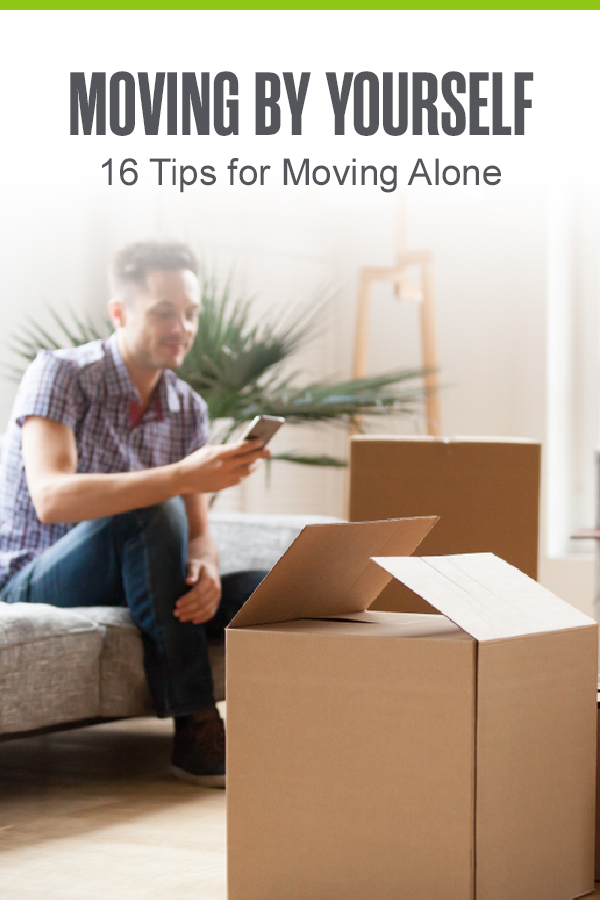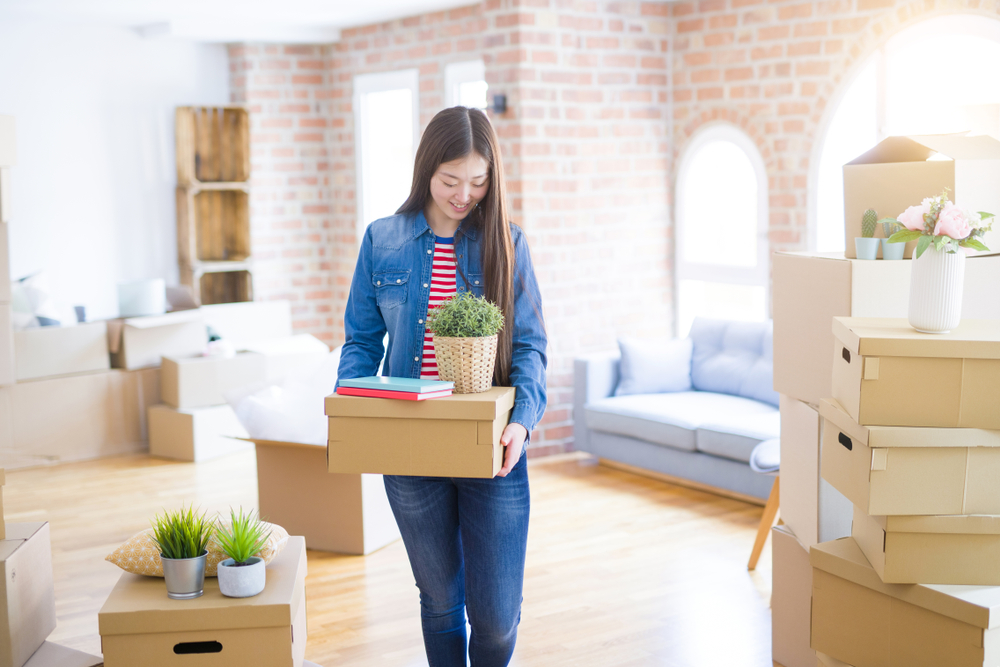Moving to a new home by yourself? A lot of preparation goes into making a move successful, and handling all of it alone can be as overwhelming as it is rewarding. Whether you’re relocating for a job or moving into your first apartment, here are 16 tips to help you prepare for moving by yourself.
Declutter Your Home
Decluttering your house is an essential first step to any move—and it’s especially helpful when you’re moving on your own. By getting rid of items you no longer need, there will be fewer boxes to haul on moving day. Sort through your belongings to decide what you want to sell, donate, or throw away. Consider selling old furniture online through exchange sites like Facebook Marketplace or Craigslist. Or get rid of a lot of items at once, try hosting a garage sale—you might even make some extra cash to help with moving-related costs!
Plan Your Move
Once you’ve set a date for your move, create a detailed moving day schedule. Take into consideration whether you’re doing a long-distance move or short-distance move, as well as the potential weather you’ll experience and the physical demand of moving. When you don’t have anyone else to load, drive, or help you navigate, it’s important to have potential roadblocks identified ahead of time so your solo move goes off without a hitch.
Reserve Moving Vehicles Early
If you’re moving without professional help, you’ll need to find a suitable moving truck or trailer. There are tons of moving truck companies out there that can meet your needs. If you’re getting a truck, try to find a pick-up and drop-off spot near your destinations to save time and money, as you’ll likely be paying for every mile. If your vehicle can handle it, trailers are great alternatives to moving trucks since they’re often less expensive and take up less space than traditional rental trucks. Whatever time of year you plan to move, make sure to reserve your moving vehicles early—some moving seasons are busier than others.
Rent a Self Storage Unit
Whether you have too much to move in one go or you’re moving items you don’t need right away, using a storage unit while moving can be beneficial. Seasonal items, furniture, and small items like books and movies are perfect for keeping in a storage unit. This can be great when downsizing your home, too. After you move into your new place, you can gradually move in the items from your storage unit when it works for you! Although this could lead to more back-and-forth trips, using temporary storage can take some of the pressure off of the big moving day. At Extra Space Storage, we offer a range of storage unit sizes and amenities like 24-hour access, climate control, and more. Stop by your local storage facility, or give us a call for more information!
Find Moving Boxes
Reusing old boxes is a great packing tip to save some money during your solo move. You can find free boxes from a wide variety of retailers. Ask your local grocery store or nearby retailer if you can take some boxes off their hands after they get a shipment in. If you can’t find enough free moving boxes to supply your move, get creative by using suitcases, securing already-packed drawers, or using plastic totes.
Gather Packing Supplies
The most important aspect of your DIY move is making sure items get to their destination safely. Packing supplies like packing wrap, bubble wrap, packing peanuts, packing tape, and mattress bags can go a long way in protecting your belongings throughout the move. You can also get a tape gun to speed up the packing process and make sure boxes are sealed securely. Many professional moving companies offer these items through their services, but you can also find these supplies at your local supermarket or home improvement store.
Pack Boxes Carefully
When you move alone, how you pack moving boxes is incredibly important. Make sure boxes are not overly heavy so they can be carried easily by one person. In each box, place the large or heavy items at the bottom first to prevent lighter objects from getting crushed. Packing heavy items or packages into smaller boxes can make them easier to carry, as well. For example, items like individual dishes or books might not be heavy, but become heavy in large quantities. In contrast, large moving boxes are perfect for carrying a lot of light items like clothes or bedding.
Label What You Pack
Create a detailed packing list of all of the things you box up and where they’ll be going in your new home. Then, pack and label your boxes accordingly with details like their designated room—or, if you want to be specific, label what’s inside like “Kitchen Utensils.” This kind of organization will be greatly beneficial as you start to unload and unpack. There are also helpful moving apps available you can use to track what you pack!
Use Moving Equipment
Moving by yourself can be physically demanding. Transporting heavy items without proper support can cause serious damage to the item and to yourself. If you can’t find anyone to help and don’t have the budget to hire professional movers, the best option is to use equipment—like quality gloves, furniture sliders, straps, and dollies—to make moving heavy items manageable. Rent moving equipment from local hardware stores, storage facilities, home improvement stores, or even moving truck rental companies. Use furniture pads, blankets, or lifting straps to transport large pieces of furniture like bookcases, couches, and beds to take the pressure off your body.
Pack an Essentials Bag
Before your DIY move, put together a bag of important items you’ll want to keep organized and easily accessible. If you’re staying in a hotel or temporary housing, you won’t want to fully unpack until you get to your new home. Keep items like toiletries, electronics, phone chargers, and a change of clothes on hand, as well as important documents like Social Security cards, birth certificates, and passports. Keeping these essential items in one place will hopefully save you from digging through all of your already-packed boxes for necessities! Last, because this is an easily-accessible box or bag, it’s a good idea to pack snacks, water, electrolyte drinks, or cooling fans to keep cool and hydrated while moving.
Move Nonessential Things First
Do you have an overlap between your previous lease agreement and your new home move-in? If so, try moving in smaller batches throughout several days, and start with nonessential items first. This can include seasonal decor, items you keep in storage, clothes, plants, books, electronics you don’t use every day, and furniture that doesn’t have a vital function. Moving a little at a time is a simple way to lessen the pressure of loading and unloading everything in one day when you’re moving on your own.
Move in the Morning & On the Weekend
A good solo moving tip is to start moving early in the day or during the weekend. Moving on the weekend is a great way to get settled into your new space if you can’t take off additional time to move. If you can hit the road early, you could avoid some delays from rush hour traffic. More importantly, you can leave time to unload later, so you won’t have to worry about working late into the night or workweek. It’s overall a good idea to plan for your move to take longer than you might expect, especially if you’re moving without help. Consider creating a moving checklist timeline to help you manage your time.
Find a Babysitter
Moving to a new home can be tricky—especially if you have little ones. Smaller children may get upset with the hustle, bustle, and general chaos of a move. To maintain safety while moving heavy items and avoid distractions like snack breaks and dirty diapers, consider asking a friend or family member to keep an eye on them! There are plenty of trustworthy resources to hire a babysitter if you’re unable to find someone or you’re short on time.
Get a Petsitter
Sometimes moving with pets can be a hassle. Pets that live in cages may need their own dedicated time to be moved, and cats and dogs may get anxious during the moving process. Consider asking friends or loved ones to watch your pets while you move. Or you can secure a pet sitter of your choice from your mobile device with a pet-sitting app.
Properly Load Items in the Vehicle
When you move with your own vehicle, fold down the seats if you can to create extra room and cut down on the number of trips. Make sure items are secured in place, so they don’t move and dislodge while you drive. However, make sure the vehicle is not so full that your view is obscured. If you choose a rental truck, it’s important to make sure to give yourself the time in both your rental agreement and schedule to fill your moving truck properly. You can even rent the truck for multiple days if you want to spread out the loading process. It’s best to load heavy items first, near the front of the truck or trailer to prevent the back end from fishtailing while you drive.
Unpack & Settle In
After moving yourself into your new home, instead of opening all of the boxes and sorting them after the move, simply put boxes in their designated rooms. Then, unpack one room at a time. Be sure to prioritize the rooms you’ll need the most right away—like your kitchen, bathroom, and bedroom. Breaking your unloading and unpacking process into smaller chunks will help you tackle all the boxes in no time.
***
Extra Space Storage has self storage facilities located across the country that can help move you to a better tomorrow. Find self storage units near you!




